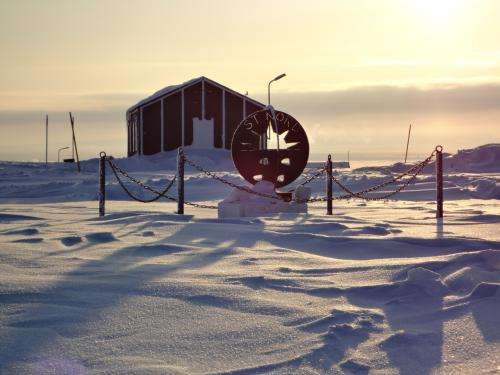Aarhus University builds research station in North Greenland

Climate change is one of the major challenges facing the international community in the coming century. The warmer climate has already had a significant impact on the distribution of the sea ice, and has led to the advancement of spring in the Arctic. There is a close connection between the Arctic climate and our own. The cold we are experiencing in Denmark at present is due to the polar front extending south, for example.
Researchers now have an unprecedented opportunity to study these climate changes at first hand, thanks to a grant of DKK 70.5 million from the VILLUM FOUNDATION as part of its research infrastructure programme.
The grant will be used to set up modern research facilities at Station North in the far north of Greenland. For a number of years, Aarhus University has been following the development of air pollution here from a small hut. This building will now be significantly upgraded, and Project Manager Henrik Skov is very pleased with the grant.
"It makes it possible to take top modern measurements and increase our presence at Station North. Our scientists will be able to carry out research that was previously impossible in the High Arctic," he says. "This way, we'll be able to extend our studies so that we not just follow air pollution, but also get to follow developments and understand the processes that exist between climate, pollution and the vulnerable ecosystems in the High Arctic. We're therefore certain that colleagues from Denmark and abroad will also be champing at the bit to join us in this work," he concludes.
"This magnificent grant from the VILLUM FOUNDATION will be very important for future Arctic research and the excellent collaboration we've got with the research institutions and authorities in Greenland. You can't find a better place to measure climate change, and Station North can therefore become a crucial reference point – not only for researchers at Aarhus University, but also for our many collaborative partners all over the world, who will benefit from the station. Aarhus University recently entered into collaboration with Canada's University of Manitoba and the Greenland Institute of Natural Resources, and the Station North grant helps to strongly emphasise the VILLUM FOUNDATION and Aarhus University's strong commitment to the climate, the environment and the Arctic," says Rector Lauritz B. Holm-Nielsen, Aarhus University.
Snowmobiles and drones
Carrying out research in the High Arctic is logistically very challenging, mainly because of its virtually inaccessible location and lack of a modern research infrastructure. It is therefore crucially important to establish suitable new research facilities in the High Arctic region. The fact that this is possible at all is due to the unique collaboration established over many years between the research group and the Danish Armed Forces.
The major climate changes taking place right now are particularly significant in the High Arctic, making it very important to describe the correlation between climate, pollution and the sensitive Arctic food chains, as well as their repercussions on the rest of the world.
The research infrastructure will be established in 2013 and 2014 at Station North in North Greenland. It will consist of three substations with ultra-modern laboratory facilities and equipment.
1. Basic station, consisting of a number of buildings with accommodation facilities and laboratories that make it possible to study the transport of pollution to the Arctic, permafrost, ice, climate and biological processes close to Station North.
2. Mobile station, consisting of snowmobiles, tracked vehicles (one or more), sleds, tents, etc., so the researchers can get around and study chemical, physical, geological and biological processes in the areas at a distance from Station North.
3. Air station, consisting of unmanned drones that make it possible to study the composition of the air and observe the Earth from the air.
The research infrastructure will be open to Danish and international researchers, partly via the new Arctic Research Centre at Aarhus University.
Setting up the research infrastructure will thus constitute an international hub for interdisciplinary research into the impact of climate change on the Arctic regions, including a deeper understanding of the effects on the sea ice, glaciers, ecosystems and atmosphere. Such studies are necessary to respond to the important scientific questions related to the accelerating Arctic warming. The Greenland Self-Government's Department of Education and Research has therefore expressed its support for the project, as it will be one of the main users of the knowledge acquired.
Arctic Research Centre
The researchers literally work at the top of the world when colleagues from different fields combine their strengths at the Arctic Research Centre. Marine scientists, chemists, physicists, biologists, statisticians, geographers and geologists have joined forces to answer the many difficult questions connected with climate change and the Arctic.
The aim is to provide world-class research that can form the basis for innovative solutions to the dramatic climate changes in the Arctic. This is a complex challenge that the new research centre takes up in international and interdisciplinary collaboration.
Provided by Aarhus University


















